Author Archive
(SAN BERNARDINO, Calif.) “Our 21st annual Black Rose Awards,” says Margaret Hill, program chairman, “honor community leaders who have graciously given of themselves to make our area the best it can be.”
The Valencia Room of the National Orange Show (689 S. East Street in San Bernardino) will be the site of this gala ceremony on Sept. 10. The San Bernardino Black Culture Foundation will recognize eight award recipients.
Heading the list as “Humanitarian of the Year” is Mr. Dorthey “Dorty” Gray who has retired from Southern California Edison and is now simply known as “Coach.”
Selected for the “Community Service Award” is the Rev. Floyd Lofton, assistant pastor of San Bernardino’s New Hope Missionary Baptist Church.
A half-dozen outstanding individuals in San Bernardino County will receive the coveted “Black Rose Award.”
§ Pastor Larry Campbell is the senior pastor at the city’s St. Paul A.M.E. Church
§ Sam Handley is the Highland Family YMCA’s Associate executive director
§ Best-selling local author, Janice Higgins, is the founder and director of Project R.A.G.E. (Release of Anger and Guilt Through Empowerment)
§ From Sovereign Employee Benefits, Inc. is CEO Ron King
§ Will Larkin is an area real estate investor
§ The Director of Youth Action Project, Inc. (YAP) is Joseph Williams
Other nominees, granted “Black Rose Recognition” by the Black Culture Foundation, are Shauna Albright, John Coleman, Dr. Betty Daniels and Brenda Parker.
Hosting the evening’s ceremony for the sixth consecutive year are California State University San Bernardino Professor of Theater Arts Kathryn Ervin and Dameron Communications Carl Dameron.
Tickets for the Black Rose Awards September 10 gala are $60 per person and $600 for reserved tables of 10. The social hour begins at 6 p.m. with the ceremony at 7 p.m. To order tickets or reserve a table, call program chairman Margaret Hill at (909) 991-6422.
“Don’t miss out,” urges Hill. “The evening will be one of the community highlights of 2010.”
-end-
Salvation Army Volunteer Helps Young People to Be Their Best
(SAN BERNARDINO, Calif.) Kelly Silvestri-Raabe thought she had lost everything last year. This year, through the Salvation Army, she has found a new life and new purpose.
The San Bernardino Salvation Army recently named Kelly as the Young People’s Sgt. Major. In this position, she oversees the programs the Salvation Army offers for children ages 6-12.
Kelly believes this simply gives a title and a written job description to the work she’s done gladly for most of 2010. It is a volunteer position, but one to which she devotes most of her time.
“It took me losing everything to see how God wanted to use me,” she said. “I love the Salvation Army. It has completed my life”
Kelly started becoming familiar with the Salvation Army when she checked into the Hospitality House shelter at the end of 2009. She came there three years after her mother’s death, which had led to a downward spiral that included divorce, losing contact with her two sons and being forced out of the house in which she had spent most of her life.
Before she lost her sons, and their father moved them to Ohio, Kelly had largely focused her life on them. She hadn’t planned it that way. Even after she became pregnant in college, she had plans to become an FBI agent, and thought that having children would require only a brief interruption in her career.
“The moment my oldest son was born, I knew that God’s purpose for my life was for me to be a wife and a mother,” she said. “I had never known that kind of love before.”
Her husband had a good job, and the family was living in Kelly’s childhood home, which her mother had sold to them a few years earlier. So, Kelly was able to quit college and become a stay-at-home mom.
When her boys started school she served as the room mother. When they began playing team sports, she served as the team mother.
“My boys were my life,” she said. “I never spent more than a day away from them.”
All that came to a stop in 2005, when her mother suffered a stroke. For the next two years until her mother died, Kelly devoted much of her time to caring for her mother.
Since Kelly’s father had died when she was 7, the feeling of being left alone after her mother’s death caused her to fall into a deep depression. “I turned my back on everyone who loved me,” she said.
Her husband eventually left, and later fled with their sons to Cincinnati, Ohio, where they now live. Kelly has had only limited phone contact with them since then.
Not too long after her husband and sons left California, Kelly came home one day to find the cam locks changed, and her possessions sitting outside. Her house had been foreclosed.
“I had nowhere to go,” she said. “One of my friends suggested the Salvation Army. I said ‘I thought that was a thrift store.’
“I walked into a room where 40 people were sleeping together on the floor, (an arrangement necessary at the time, because the Hospitality House emergency family shelter operated from the Salvation Army Corps headquarters building). I had never felt so safe, because no one looked down on me, they just showed me love and kindness.”
While she was in the shelter, Kelly reached out to the children living there.
“The parents didn’t have anything for them to do,” she said. “When kids are left to their own devices, they can get into trouble.”
She took the shelter’s children on small outings to a nearby park and to the grocery store. On Thursdays, usually a minimum day at the elementary school where shelter children attend, she spent the afternoons teaching them craft projects. She served ice cream to them and baked cakes for them.
“These kids are so thankful for these little things,” Kelly said. “It is a blessing to be able to work with them.”
Once she left the shelter, her work with the children continued and grew. She volunteered with Sunbeams and Adventure Corps, programs the Salvation Army offers during the week to children in first through sixth grade.
In the spring, she participated with them in the Salvation Army’s annual Pinewood Derby, where children and youth leaders from many Corps create racecars from wood and engage them in races on a sloping track. She won.
In the summer, she went with the children to Salvation Army summer camp and taught them to ride bicycles. She took 27 little girls to see a live performance of “The Little Mermaid.”
Now, she is also responsible for Junior Church, a program held on Sunday mornings for children ages 7-12. She also leads Junior Salvationists, a program that prepares preteens to serve their community as part of the Salvation Army Church.
She believes she has found her true calling.
“I had a very comfortable life with my husband and I thought I was happy, she said. “Now, materially, I don’t have anything. But I have so much joy.”
About the Salvation Army San Bernardino Corps
The Salvation Army may be able to provide emergency services including food; lodging for homeless or displaced families; clothing and furniture; assistance with rent or mortgage and transportation when funds are available. The Salvation Army Team Radio Network assists rescue workers and evacuees in such disasters as fires.
The Salvation Army is an evangelical part of the Universal Christian church and also offers evangelical programs for boys, girls and adults. One of the largest charitable and international service organizations in the world, The Salvation Army has been in existence since 1865 and in San Bernardino since 1887, supporting those in need without discrimination. Donations may always be made online at www.salvationarmyusa.org or by calling 1-(800)-SAL-ARMY.
For local help, call (909) 888-1336.
-end-
Media: If you would like any of the photos in the slide show below please send an email to Chris@DameronCommunications.com with the photo id number and i will have it to you within 24 hours. If you require the photo sooner please call Chris Sloan at (909) 888-0017.
Ad Club Party to Benefit Youth Hope
(San Bernardino, CA) The annual Holiday Party sponsored by the Inland Empire ad club is scheduled for Thursday, Dec. 9 in Rancho Cucamonga.
This year, proceeds will benefit Youth Hope, a non-profit shelter for runaway and homeless youth in the Inland Empire.
“We are very excited to support Youth Hope,” said Victoria Seitz, President of the Inland Empire Chapter of the American Advertising Federation (AAF). “This organization does a remarkable job of working with and protecting our young people, especially during the holiday season. I encourage all AAF members and the public to join us for a wonderful Holiday Party for such a good cause.”
Seitz said the party will feature a multicultural night of food, languages, music, entertainment and dancing, celebrating holiday traditions from around the world. Food will be provided by The Pines and many door prizes will be raffled off. “This will be a fabulous party, one that is not to be missed. Be sure to register in advance.”
The holiday celebration will be held at Steve Scudder Photography and Digital Empire Studio, 8431 Utica Ave., Rancho Cucamonga, from 6:30-10PM. Cost is $40 per person and $50 at the door. The event is open to the public.
To register or for more details, visit http://aaf-inlandempire.com/ or call (909)720-3932.
City of San Bernardino Seniors Discuss Urgent Housing Needs

Carey Jenkins, San Bernardino Economic Development Agency’s Director of Housing and Economic Development, taking questions from local residents, concerning proposed rehabilitation of the Lugo Apartment complex. Photo by Chris Sloan
(SAN BERNARDINO, Calif.) Elected officials, community leaders and local residents gathered as San Bernardino City 1st Ward Councilmember Virginia Marquez and the San Bernardino Housing and Community Development staff, held an informational meeting regarding the acquisition and rehabilitation proposed for the Lugo Apartments, located at 839 Lugo Avenue.
“Tonight our focus is you, the community,” said councilmember Marquez. “I urge everyone to be engaged and to ask questions. It is important for you to tell us what is wanted and what is important to you. This is our neighborhood.”
Scheduled for presentation during the San Bernardino City Council December 6 meeting, the project has been proposed as an affordable senior living housing complex. Held at St. Paul’s United Methodist Church, the gathering gave attendees a chance to share their thoughts and concerns, as they discussed the development, cost and management of this project.
According to the City’s 2010 Consolidated Plan, San Bernardino has approximately 7,100 vacant dwelling units, which includes a mix of single family, three and four-plex properties, as well as larger scale multi-plex properties. In addition, a study conducted in 2008 revealed the city is approximately 1,000 units below what is needed for an aging population in the form of affordable senior housing.
“I think tonight was very informative and step in right direction,” said San Bernardino Police Officer Aaron Jones, who patrols the Lugo Apartment neighborhood. “If everything falls in place, as explained, this should make the community a much safer place.”
Currently 120 units, the Lugo Apartments has fallen victim to urban blight and increased criminal activity. Centrally located, the proposed project is seen as playing a key role in reducing many of the problems in the neighborhood and will go a long way in bringing the City in line with the projected need for affordable senior housing as well.
“Ultimately, our plan is to transformed the property into a 119-unit senior-only complex, with a community clubhouse,” said Carey Jenkins, San Bernardino Housing and Community Development director. “It sits on approximately 3 acres and once transformed, this project will go a long way in providing enhanced amenities for our growing population of seniors.
Carrying a total development cost of $18.5 million, the San Bernardino Economic Development Agency will look to partner with Meta Housing Corporation to develop and manage the complex. The San Bernardino Economic Development Agency’s agreed upon subsidy for the project is set at $6.5 million. Funding will subsidize a portion of the site acquisition, assist with tenant relocation and pay for pre-development cost.
Meta Housing Corporations is a Los Angeles-based firm specializing in the development and financing of affordable and market-rate apartment communities for families and seniors, has been proposed as the developer on this project, based on their expertise in acquiring and rehabilitating existing residential units to suit senior living.
“I think this is a great idea,” said local resident Lillice Andreson. “Normally I am very leery about this type of thing, where people can potentially loose their homes, but this is nothing like that. This neighborhood desperately needs an affordable senior facility.”
Meta Housing Corporation has built a reputation of offering amenities and programs that help senior residents embrace the full potential of a high quality lifestyle. Once completed, the complex will feature new interior flooring, paint, energy efficient light and heating, new faucets and toilets in the bathrooms, and new kitchen countertops, appliances and cabinets.
The exterior will offer new property line perimeter wall, landscaping, wheelchair accessible ramps, reconstruction of carports, dual glazed energy efficient windows, new roof, new paint, new asphalt parking and driveway areas, as well as elevators and bridges between buildings for handicapped access.
Plans for a community clubhouse have been developed, designed to create a social gathering space. The clubhouse will offer a fully equipped library, computer room, guest parking and security access gate. There will also be on-site tenant services that include health and wellness classes, lifelong learning and creative arts programs.
“I thought the reaction from the attendees has been very positive and there seems to be support for this,” said Jenkins. “This is the first step, it is a process and we are here to make sure we listen to the community and address any concerns they may have.”
For more information on this project call Carey Jenkins at the City of San Bernardino Economic Development Agency at (909) 663-1044.
-End-
Media: If you would like any of the photos in the slide show below please send an email to Chris@DameronCommunications.com with the photo id number and i will have it to you within 24 hours. If you require the photo sooner please call Chris Sloan at (909) 888-0017.
Young Graphic Designer Interns At Dameron Communications
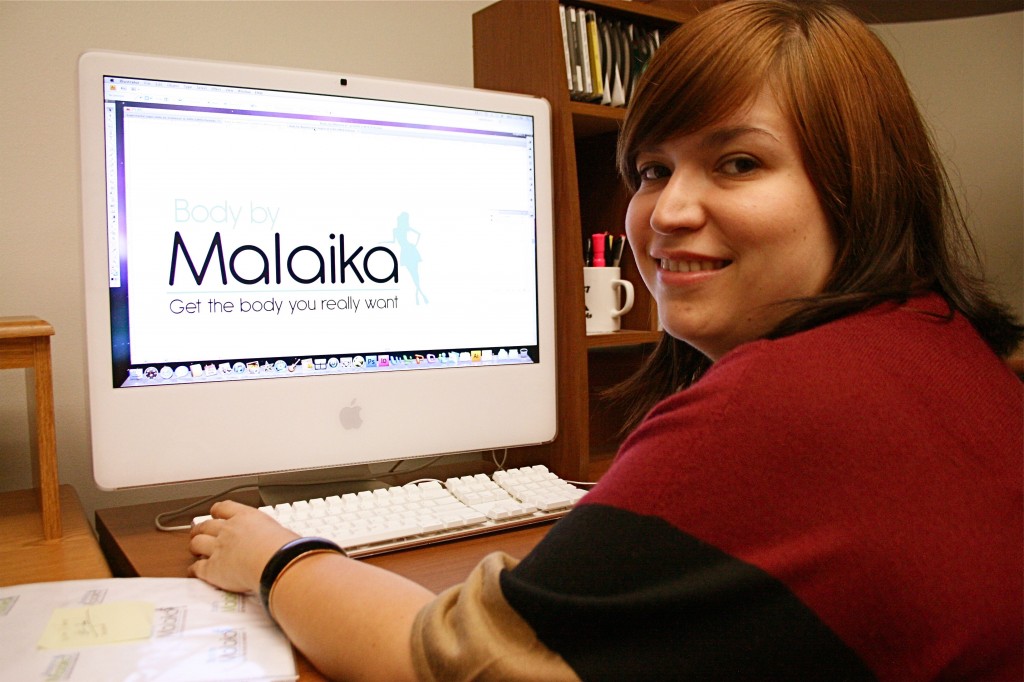
One of the projects Erica Velazquez worked on during her internship was to help design a logo for Body by Malaika. Photo by Chris Sloan
An internship is a temporary 10-week training period at a company within the student’s field of study. During this time a student is trained to be a professional, as well as taught the basics of their field. Some interns are even hired on completion of their internship.
“If we want to make sure young graphic artist professionals are properly trained, we need to help train them,” said Carl Dameron, creative director of Dameron Communications.
Prior to attending the Art Institute of California-Inland Empire, Velazquez created paintings, textiles and photography. Her work was featured in art galleries in Pomona, Upland and Riverside since the age of 20.
She studied photography at Citrus Community College in Glendora California and it was here where Velazquez began working with the basic graphic design programs such as Adobe Photoshop, InDesign and Illustrator.
In 2009 she worked for the Career Service Department at the Art Institute of California-Inland Empire were she created graphic design layouts for all the departments at the college while attending classes at the institute.
“Frank Houlihan, graphic design instructor and internship class instructor, recommended me to apply at Dameron Communications for my internship,” said Velazquez.
It was there that Velazquez learned how to better interact with business professionals.
“I have learned how to work with others in an office environment, how to market to a target audience and how to collaborate with others to create the best product for a client.”
While working side by side with Thom Salisbury, Dameron Communications’ Senior Art Director, Velazquez learned new techniques in Illustrator and even learned how to you use Quark, a graphic design program she had not used prior to her intern.
One of Velazquez’s many projects was to create an identity for personal trainer Malaika Jacocks-Dameron. This included the logo as well as determining what message the trainer wanted to send to her target audience.
“I was honored to be able to create an identity for Malaika Jacocks-Dameron’s company Body by Malaika.”
Upon completing her degree in graphic design at the Art Institute of California-Inland Empire, she wishes to continue her education and earn a degree in environmental design. Velazquez then plans to pursue a masters’ degree in fashion design with an emphasis in graphic design.
For more information go to DameronCommunications.com or call (909) 888-0017.
About Dameron Communications, LLC
Since 1989 Dameron Communications has creatively met the needs of our diverse client base locally, regionally and nationally. It is an award-winning agency that creates integrated advertising and public relations solutions to increase clients’ sales and profits, win elections, inform the public or gain acceptance of potentially controversial issues.
Dameron Communications creates advertising for television, radio, newspaper, magazine, and billboards, web sites, mobile web applications, email and more. Public relations services include press releases, press conferences, media relations, television programs, web sites, opinion editorials, promotions, event creation and management, government relations and community relations.
Dameron Communications has earned media coverage for clients from: ABC, CBS, NBC, CNBC, CBS MarketWatch; Fox News, CNN, Nightly Business Report; The Wall Street Journal, New York Times, Los Angeles Times, The Washington Post, Dow Jones News Wire, Bloomberg, Reuters, Associated Press, The Press Enterprise, The Sun, The Daily Bulletin, The Daily News, The Daily Press and many more.
-end-
Pies Served by Helping Hands
Inland Empire Job Corps culinary arts students Rene Ortiz, Courtland Akken, Vincent Flores, Jenavie Del Toro, Rory Simms, Calvin Poindexter and Pedro Castillo, joined Salvation Army Corps Officer Nancy Ball, Salvation Army volunteer Kathy Brown, Inland Empire Job Corps Learning Director Greg Trammel and Inland Empire Job Corps Executive Chef/Culinary Instructor Michael Geurds in packing boxes that will be used to fill holiday gift baskets for needy families. The students volunteered their help with sorting and packaging after dropping off 100 donated pumpkin pies to the Salvation Army for its recent Thanksgiving dinner.

(SAN BERNARDINO, Calif.) Delivering pies to the Salvation Army is a holiday tradition for the Inland Empire Job Corps. Every year before Thanksgiving, they bring enough to feed at least 800 people.
This year, seven students from Job Corps culinary arts program went a step further.
After setting 100 pumpkin pies down in the Salvation Army Corps Headquarters kitchen, the students noticed Salvation Army volunteers and staff packing cans and other non-perishable food items into boxes in the community room. The Job Corps students rolled up the sleeves of their chef’s robes, and set to work helping to sort and pack.
“They took that on themselves,” said Chef Michael Geurds, instructor for the culinary arts program. “They saw a need and wanted to help. Our students are always helping others in the community.”
These boxes of food will create holiday baskets the Salvation Army plans to deliver to about 700 families a few days before Christmas.
“The Job Corps students are a great group of helpful young people, and we appreciate the effort and energy they put into helping us every year during the holiday season,” said Capt. Nancy Ball, Salvation Army Corps officer.
They have been providing community service to The Salvation Army for about a decade.
Last year, three students won a culinary competition and donated the $300 prize to the Salvation Army. The past two years, they donated to the Salvation Army and other organizations a collection of gingerbread homes they had created from scratch as a class project.
Inland Empire Job Corps’ service goes beyond donations. They also frequently help with the preparation and serving of up to 200 meals served at Headquarters throughout the year, and with the maintenance of the grounds of The Salvation Army’s buildings.
About the Salvation Army San Bernardino Corps
The Salvation Army may be able to provide emergency services including food; lodging for homeless or displaced families; clothing and furniture; assistance with rent or mortgage and transportation when funds are available. The Salvation Army Team Radio Network assists rescue workers and evacuees in such disasters as fires.
The Salvation Army is an evangelical part of the Universal Christian church and also offers evangelical programs for boys, girls and adults. One of the largest charitable and international service organizations in the world, The Salvation Army has been in existence since 1865 and in San Bernardino since 1887, supporting those in need without discrimination. Donations may always be made online at www.salvationarmyusa.org or by calling 1-(800)-SAL-ARMY.
For local help, call (909) 888-1336.
-end-
Share The Joy Of Christmas With A Child

To share Christmas joy with a deserving child, come to Inland Center Mall anytime between Nov. 26 and mid-December and select a tag indicating that child’s age, sex and gift preference. Or find and order a gift for a local child online at jcp.com/angel. Photo by Carl Dameron
In San Bernardino County, these programs, known as the Angel Giving Tree programs, revolve around actual Christmas trees. These trees will be set up in local malls the day after Thanksgiving to match shoppers with the hundreds of children in each location who are relying on the Salvation Army this year to bring a Merry Christmas.
Attached to branches of the tree are cards with names of children whose families simply cannot afford to buy gifts, as much as they would love to. Shoppers who want to take part by helping disadvantaged children simply pluck a tag off the Giving Tree, read the child’s name and wish list, then head for the appropriate store for a little sharing of their own.
“Why not start a tradition with your family and select a gift for a needy child together,” Capt. Nancy Ball said.
San Bernardino Corps puts its Giving Tree in the Inland Center Mall (500 Inland Center Drive, San Bernardino) near the food court.
“I always find it very heartwarming and satisfying to be able to purchase a gift for one of these children, based on his or her wishes,” said Tom Brickley, who is the president of the Salvation Army’s advisory board, and has participated in the Giving Tree for a number of years. “For some, it may be the only gift they get all year.”
“It is a neat way to give the child the gift he or she wants,” Brickley said. “Some want bicycles, some pants, others a specific toy.”
The Ontario Corps puts trees in Ontario Mills Mall (1 Mills Circle, Ontario) in front of JC Penney’s and Montclair Plaza (5060 E. Montclair Plaza Lane, Montclair) inside the Macy’s store. The Redlands Corps puts a tree at Wal-Mart (2050 W. Redlands Blvd., Redlands).
However, not all corps have actual trees. The Riverside Corps asks shoppers to call (951) 784-4490, ext. 114 to obtain the name of and requests of more than 2,000 children on its “Angel” list.
Since online shopping is also a popular way to buy Christmas gifts, JC Penney’s has a partnership with the Salvation Army allowing shoppers to go to jcp.com/angel and search for children (and in some places senior citizens) in any ZIP Code. The website allows online shoppers to order a gift for them from JC Penney’s online catalog, and gives them the choice of dropping the gift off at their local Salvation Army’s collection center, or of having UPS ship it, at no charge, to that collection center.
The Salvation Army also is looking for other businesses in both San Bernardino and Riverside counties, who would like to have a tree at their place of business for employees and/or customers.
To host an Angel Tree in San Bernardino, Colton, Grand Terrace, Rialto, Bloomington or Highland, call (909) 888-1336. Elsewhere, call 1-(800)-SAL-ARMY.
“This is a great way for business owners and managers to help the community this Christmas,” Capt. Ball said.
“Soccer balls, dolls and clothes are just a few items on each child’s wish list,” Capt. Ball said. “Shoppers who participate in the program are encouraged to shop for more than what is needed on the list.”
Salvation Army volunteers make sure the presents are earmarked for the specific child.
About the Salvation Army San Bernardino Corps
The Salvation Army may be able to provide emergency services including food; lodging for homeless or displaced families; clothing and furniture; assistance with rent or mortgage and transportation when funds are available. The Salvation Army Team Radio Network assists rescue workers and evacuees in such disasters as fires.
The Salvation Army is an evangelical part of the Universal Christian church and also offers evangelical programs for boys, girls and adults. One of the largest charitable and international service organizations in the world, The Salvation Army has been in existence since 1865 and in San Bernardino since 1887, supporting those in need without discrimination. Donations may always be made online at www.salvationarmyusa.org or by calling 1-(800)-SAL-ARMY.
For local help, call (909) 888-1336.
-end-
Help a Neighbor – Volunteer to Ring a Silver Bell
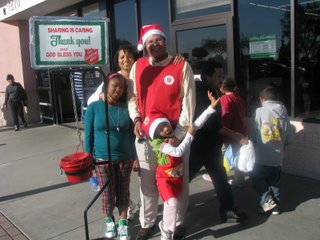
The Dameron family (Shiane, Malaika, Carl and Shaila) volunteer each year for an entire day as Salvation Army bellringers. If your family, organization or business can supply enough people to ring bells at one of the San Bernardino Corps Red Kettle locations for an entire day, please volunteer by calling (909) 888-1336.
(San Bernardino, Calif.) –The Salvation Army is gearing up for its Christmas tradition of ringing silver bells by shiny red kettles, so that passersby have a trustworthy opportunity to help those less fortunate.
“The Red Kettle fund raiser is our biggest fund raiser of the year,” said Capt. Nancy Ball, corps officer of The Salvation Army San Bernardino Corps. “We use the funds received to support our programs year-round to provide food, shelter and youth programs to our community.
The Salvation Army will continue ringing bells, Monday through Saturday until Christmas Eve. It seeks volunteer bell-ringers so that it can staff even more locations, more of the time.
For the past several years, Salvation Army of San Bernardino board member, and Dameron Communications founder and creative director, Carl Dameron volunteered with his wife Malaika and two daughters, Shaila and Shiane. The entire Salvation Army of San Bernardino board also volunteered their time to ring silver bells and ask the community for help.
“We receive great satisfaction knowing we had made a difference in our community,” Carl Dameron said. “We also enjoyed spending the time together as a family and teaching our children about the responsibility we have to care for those in our community who are less fortunate.”
Capt. Ball encourages families, groups of friends, community organizations, churches and Sunday school classes to sign up as a “Bell Ringer for A Day.” The Salvation Army especially seeks groups large enough to work in shifts throughout am eight-hour day, such as Rotary, Lions or Elks clubs, youth groups, church groups and large employers.
Each Thanksgiving the Salvation Army Corps of San Bernardino serves about 500 people holiday meals. It serves almost as many meals on a daily basis to those who are homeless and hungry.
Feeding the hungry is just one of the ways money donated to The Salvation Army helps. Salvation Army Corps offers lodging for homeless or evicted families; clothing and furniture for burnout victims, and assistance with rent/mortgage, utilities and transportation when funds are available. The Salvation Army Team Radio Network assists rescue workers and evacuees in disasters such as fires.
In San Bernardino, The Hospitality House provides temporary emergency shelter and support in rebuilding the lives of thousands of homeless families.
To volunteer as a bellringer in San Bernardino, Colton, Rialto, Grand Terrace, Bloomington or Highland, call (909) 888-1336.
In addition, one may donate to The Salvation Army online, through the website www.salvationarmyusa.org. Donors may specify to which branch of The Salvation Army the money should be sent.
How the Bell Ringer campaign began:
Capt. Joseph McFee, serving with the San Francisco Salvation Army Corps back in 1891, wanted to serve Christmas dinner to the poor in his neighborhood. But he didn’t have money to do so.
Mc Fee remembered as a sailor in Liverpool, England, seeing people on the docks throw money into a large kettle called “Simpson’s Pot” to help the poor. He decided this might work in California, too.
He set up a kettle at the Oakland Ferry Landing, which operated a ferry that was, in those days, the only way across San Francisco Bay. He put a sign on the kettle saying, “Keep the Pot Boiling” and raised enough money to serve the Christmas dinner.
His idea spread quickly, and by 1897 Salvation Army Corps nationwide were collecting money in kettles to serve the needy in their communities. Among The Salvation Army Corps collecting money this way before the turn of the 20th Century was The Salvation Army of San Bernardino, which formed in 1887.
About the Salvation Army San Bernardino Corps
The Salvation Army may be able to provide emergency services including food; lodging for homeless or displaced families; clothing and furniture; assistance with rent or mortgage and transportation when funds are available. The Salvation Army Team Radio Network assists rescue workers and evacuees in such disasters as fires.
The Salvation Army is an evangelical part of the Universal Christian church and also offers evangelical programs for boys, girls and adults. One of the largest charitable and international service organizations in the world, The Salvation Army has been in existence since 1865 and in San Bernardino since 1887, supporting those in need without discrimination. Donations may always be made online at www.salvationarmyusa.org or by calling 1-(800)-SAL-ARMY.
For local help, please call (909) 888-1336.
http://news.yahoo.com/video/losangelescbs2-15750780#video=23100335
-end-
Needy Families Come Together To Give Thanks

The Salvation Army San Bernardino Corps will serve a traditional Thanksgiving dinner on Thanksgiving Day, Nov. 25, and needs people to donate food and time. As these youth have discovered, it is a great opportunity for a family or an organization to work together for the good of their community. Photo by Ricardo Tombac
The San Bernardino Corps will serve dinner from 11 am to 1 pm on Thanksgiving Day, Thursday, Nov. 25, at its Corps headquarters building, 746 W. Fifth St.
“We’re serving a wonderful Thanksgiving dinner with turkey, potatoes, gravy, stuffing, vegetables and pie,” said Capt. Nancy Ball, Corps officer.
California State Senator Gloria Negrete-McLeod has donated some of the turkeys. The Inland Empire Job Corps is continuing its annual tradition of donating approximately 300 pies for the event.
“We still need lots of turkeys and lots of side dishes,” said Roosevelt Carroll, director of the Hospitality House and coordinator of the Thanksgiving dinner. “Whatever people have on their heart to donate, we need.”
The Salvation Army encourages donation of turkey or ham, side dishes and other food by calling (909) 888-1336 to make arrangements in advance, or to volunteer to help serve the Thanksgiving dinner.
The annual Thanksgiving meal brings in hundreds of families and individuals who do not have the means to provide themselves a Thanksgiving dinner. People come from all parts of the Inland Empire for the celebrations. The San Bernardino event has served close to 500.
The hungry families are joined by dozens of volunteers for the day who help prepare the food and serve meals to the families. An estimated 125 volunteers helped the San Bernardino Corps in 2009.
“Thanksgiving should be a special day for everyone, not just for those who can afford it,” says Capt. Ball.
Other Salvation Army Corps in the Inland Empire are also planning Thanksgiving dinners, although many of these will take place the day before Thanksgiving. To receive information about the dates and times for the dinners at other corps, or to volunteer please call 1800-SAL-ARMY or 1-800-725-2769.
About the Salvation Army San Bernardino Corps
The Salvation Army may be able to provide emergency services including food; lodging for homeless or displaced families; clothing and furniture; assistance with rent or mortgage and transportation when funds are available. The Salvation Army Team Radio Network assists rescue workers and evacuees in such disasters as fires.
The Salvation Army is an evangelical part of the Universal Christian church and also offers evangelical programs for boys, girls and adults. One of the largest charitable and international service organizations in the world, The Salvation Army has been in existence since 1865 and in San Bernardino since 1887, supporting those in need without discrimination. Donations may always be made online at www.salvationarmyusa.org <http://www.salvationarmyusa.org> or by calling 1-(800)-SAL-ARMY.
For local help, please call (909) 888-1336.
-end-
80 Units of Affordable Luxury Soon Available for San Bernardino Seniors
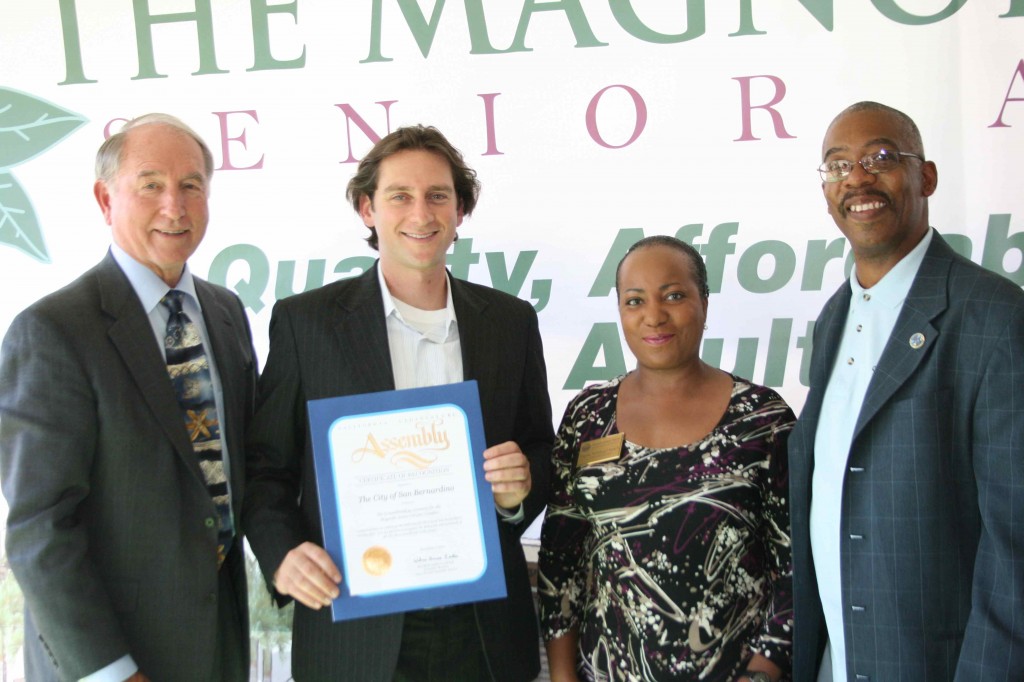
Aaron Mandel of Meta Housing, second from left receives a certificate of appreciation presented to him by Senior Field Representative Sheila Futch on behalf of Assembly Member Wilmer Amina Carter as Mayor Pat Morris, and Ward 6 Council Member Rikke Van Johnson watch.
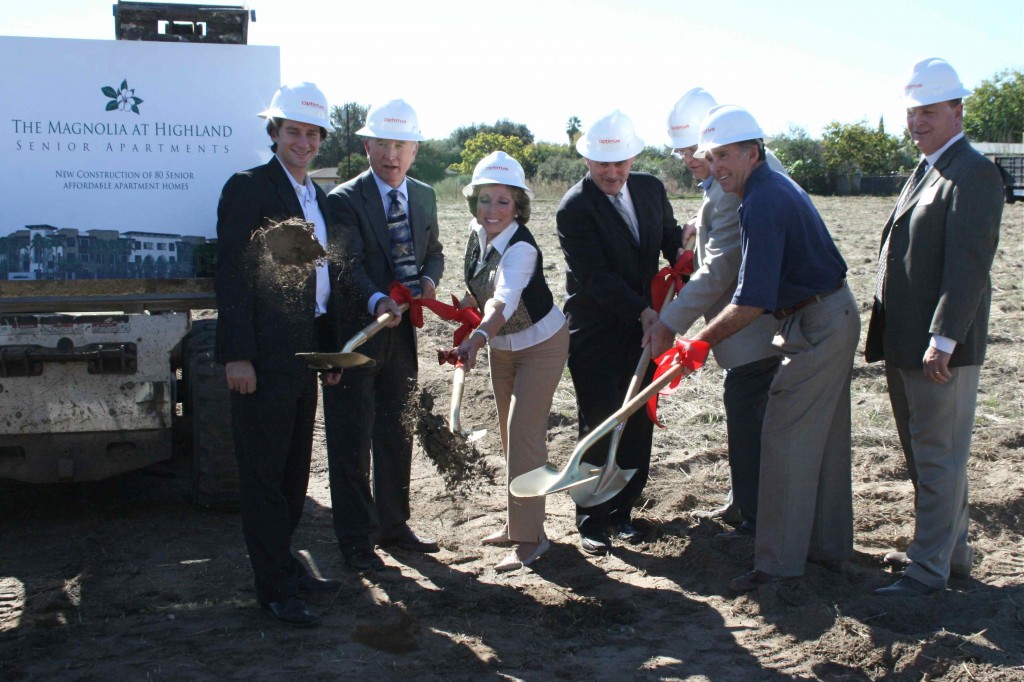
Left to right): Aaron Mandel-Meta Housing, Mayor Pat Morris, Josie Gonzales-5th District Supervisor, Graham Espey-Jones-Western Community Housing, John Huskey- Meta Housing, Fred Shorett-Council Member Ward 4, Jeffrey Boysen-President of Optimus Construction Inc. turn over the first shovels of dirt at a new luxury senior housing project, Magnolia at Highland. Photo by Chris Sloan.
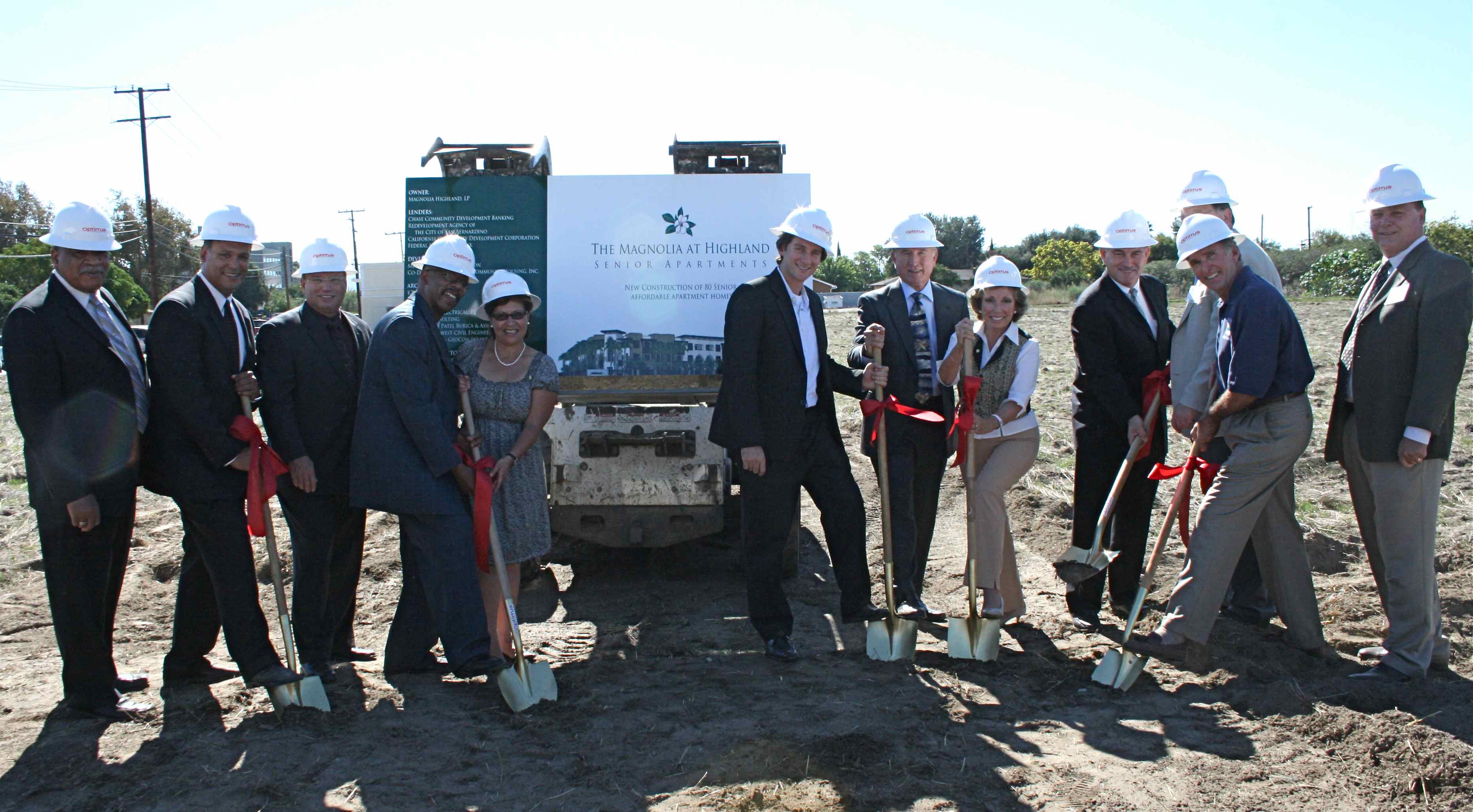
(Left to right): Pastor Ray Turner, Carey Jenkins-Director of Housing & Community Development, Emil Marzullo-Executive Director of San Bernardino Economic Development Agency, Rikke Van Johnson-Council Member Ward 6, Virginia Marquez-Council Member Ward 1, Aaron Mandel-Meta Housing, Mayor Pat Morris, Josie Gonzales-5th District Supervisor, Graham Espey-Jones-Western Community Housing, John Huskey- Meta Housing, Fred Shorett-Council Member Ward 4, Jeffrey Boysen-President of Optimus Construction Inc. dig in to start construction of a new luxury senior housing project, Magnolia at Highland. Photo by Chris Sloan
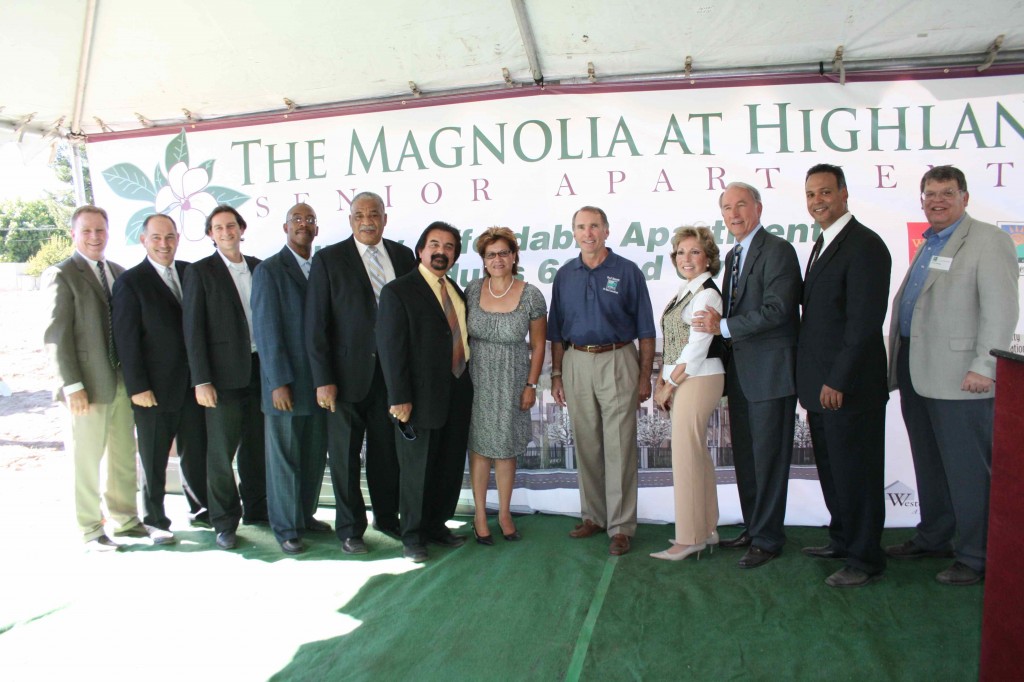
8992: (left to right): Jeffrey Boysen-President of Optimus Construction Inc, Graham Espey-Jones-Western Community Housing, Aaron Mandel-Meta Housing, Rikke Van Johnson-Council Member Ward 6, Pastor Ray Turner, Milo Victoria-CEO/General Manager, Virginia Marquez-Council Member Ward 1, Fred Shorett-Council Member Ward 4, Josie Gonzales-5th District Supervisor, Mayor Pat Morris, Carey Jenkins-Director of Housing & Community Development, John Huskey- Meta Housing at the Magnolia at Highland groundbreaking ceremony. Photo by Chris Sloan
(SAN BERNARDINO, Calif.) Residents in the City of San Bernardino will soon have affordable luxury living available on the west side of town, for individuals age 62 and older, courtesy of The Magnolia at Highland Project.
San Bernardino County Supervisor Josie Gonzales, City of San Bernardino Mayor, Patrick Morris, San Bernardino City Councilman Rikke Van Johnson, along with a host of city officials and dignitaries, came together at a recent ground breaking for this luxury senior citizen housing complex.
“This day signals the beginning of a transformation of what was once a blighted automotive site, into a high quality residential community for one of our most treasured resources – our seniors,” said Mayor Morris.
Located on the South West corner of Highland and Medical Center Drive, the project is declared to be a milestone for the City of San Bernardino and was the result of a study conducted in 2008 that revealed the city was approximately 1,000 units below what is needed for an aging population in the form of affordable senior housing.
“This is one more great project for the city of San Bernardino. I am always here to support projects such as this,” said San Bernardino County Supervisor Josie Gonzales.
Scheduled for a January 2012 opening, the community will have an on-site community advisor, offering seniors multiple educational and social activities. If that is not enough, a luxury resort level setting, with a choice of three separate floor plans, will also surround them.
The first floor plan is a one-bedroom unit of approximately 589 square feet with a patio or balcony. The two other plans consist of 2-bedroom units of approximately 828 square feet and 971 square feet, also with patios or balconies.
An outdoor patio area with shade trees, a fountain, barbecue grills, a swimming pool and adequate areas for relaxed seating will enhance the exterior of the facility. A walking path around the perimeter of the building will allow residents the opportunity for exercise while at the same time providing them with a sense of security as the path will be within a decorative 6-foot wrought iron fence that surrounds the project.
“This is the culmination of several years of hard work,” said Carey Jenkins, San Bernardino Economic Development Agency’s Housing and Community Development Director. “It is exciting to move forward with a project that has an immediate benefit to the residents and the city, while we continue our efforts to revitalize the west side of San Bernardino.”
Carrying a total development cost of $19 million, the San Bernardino Economic Development Agency partnered with Optimus Construction, Inc., Wells Fargo Bank, Chase, California Community Reinvestment Corporation, Western Community Housing Management and Meta Housing to reach their goal.
The San Bernardino Economic Development Agency’s agreed upon subsidy for the project is $7 million from its redevelopment low and moderate income housing funds. These funds are for housing only and cannot be used for city’s general fund.
The project has also retained a one-acre parcel of land for future sale or development opportunities, and creates a future stream of income that can be used for developments including senior or single-family housing.
“This was the easiest city we ever worked with,” said John Huskey of Meta Housing, Inc. “They were very responsive and really made the effort to provide us with the input we needed, in a timely fashion, which enabled us to provide them with what they really wanted.”
For more information on this project call Carey Jenkins at the City of San Bernardino Economic Development Agency at (909) 663-1044.
-end-
Media: If you would like any of the photos in the slide show below please send an email to Chris@DameronCommunications.com with the photo id number and i will have it to you within 24 hours. If you require the photo sooner please call Chris Sloan at (909) 888-0017.





